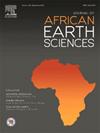刚果(金)东部Twangiza金矿周边地下水理化特征及水质评价
IF 2.2
4区 地球科学
Q2 GEOSCIENCES, MULTIDISCIPLINARY
引用次数: 0
摘要
本研究的重点是作为当地居民饮用水来源的Twangiza金矿周围的地下水,目的是根据其物理化学性质对其进行表征。采用常规分析方法,对13份水样进行理化特征分析(pH、TDS、EC、TSS、主要阳离子和阴离子)。结果显示为酸性至中性,范围为4.5至7.1,其中76.9%为酸性(pH值4-6.5),低于世卫组织和欧盟允许限值。地下水水化学相显示矿区附近为Mg-Ca-SO4型水,显示与含金硫化物溶蚀有关的硫酸盐印记,矿区下游为Ca-Mg-HCO3型水,与碳酸盐矿物关系较多。根据物化参数的相似性,通过多元统计分析对地下水进行分组,指出了成矿作用中地质过程和人为活动的部分。水岩相互作用主要表现为硅酸盐风化作用,并在矿区周边地区表现为硫化物溶蚀作用。钠吸附率为优至良,整体碱化力低,适合灌溉。水质指数(WQI)表明,除了在活动矿井内的一个站点被分类为差外,大多数站点的当地地下水质量从优到好。这些发现有助于了解地下水矿化过程,有助于地下水的可持续利用。本文章由计算机程序翻译,如有差异,请以英文原文为准。
Physicochemical characterization and quality assessment of groundwater around the Twangiza gold mine (Eastern D.R. Congo)
The present study focuses on groundwater around the Twangiza gold mine, which serve as a source of drinking water for the local population, with the aim of characterizing it based on its physicochemical properties. A total of 13 water samples were collected for analysis of physicochemical characteristics (pH, TDS, EC, TSS, major cations and anions), using conventional analytical methods. The results indicated acidic to neutral and ranged from 4.5 to 7.1, with 76.9 % acidic (pH 4–6.5), below WHO and EU permissible limits. The hydrochemical facies of groundwater revealed Mg-Ca-SO4 water types in the vicinities of the mine, indicating sulphate imprint related to the dissolution of gold bearing sulphides, and Ca-Mg-HCO3 types downstream the mine, more associated with carbonate minerals. Multivariate statistical analysis grouped groundwater based on similarities of physicochemical parameters and indicated the parts of geogenic process and anthropogenic activities in the mineralization. Water-rock interactions involved mainly silicate weathering and indicated the role of sulphide dissolution in the surrounding areas close to the mine. The sodium adsorption rate classified the water as excellent to good, with an overall low alkalizing power, which makes the water suitable for irrigation. The Water Quality Index (WQI) indicated that local groundwater quality ranged from excellent to good across most stations, with the exception of one station within the active mine classified as poor. These findings are helpful for the understanding of groundwater mineralization processes and would assist in the sustainable use of groundwater.
求助全文
通过发布文献求助,成功后即可免费获取论文全文。
去求助
来源期刊

Journal of African Earth Sciences
地学-地球科学综合
CiteScore
4.70
自引率
4.30%
发文量
240
审稿时长
12 months
期刊介绍:
The Journal of African Earth Sciences sees itself as the prime geological journal for all aspects of the Earth Sciences about the African plate. Papers dealing with peripheral areas are welcome if they demonstrate a tight link with Africa.
The Journal publishes high quality, peer-reviewed scientific papers. It is devoted primarily to research papers but short communications relating to new developments of broad interest, reviews and book reviews will also be considered. Papers must have international appeal and should present work of more regional than local significance and dealing with well identified and justified scientific questions. Specialised technical papers, analytical or exploration reports must be avoided. Papers on applied geology should preferably be linked to such core disciplines and must be addressed to a more general geoscientific audience.
 求助内容:
求助内容: 应助结果提醒方式:
应助结果提醒方式:


